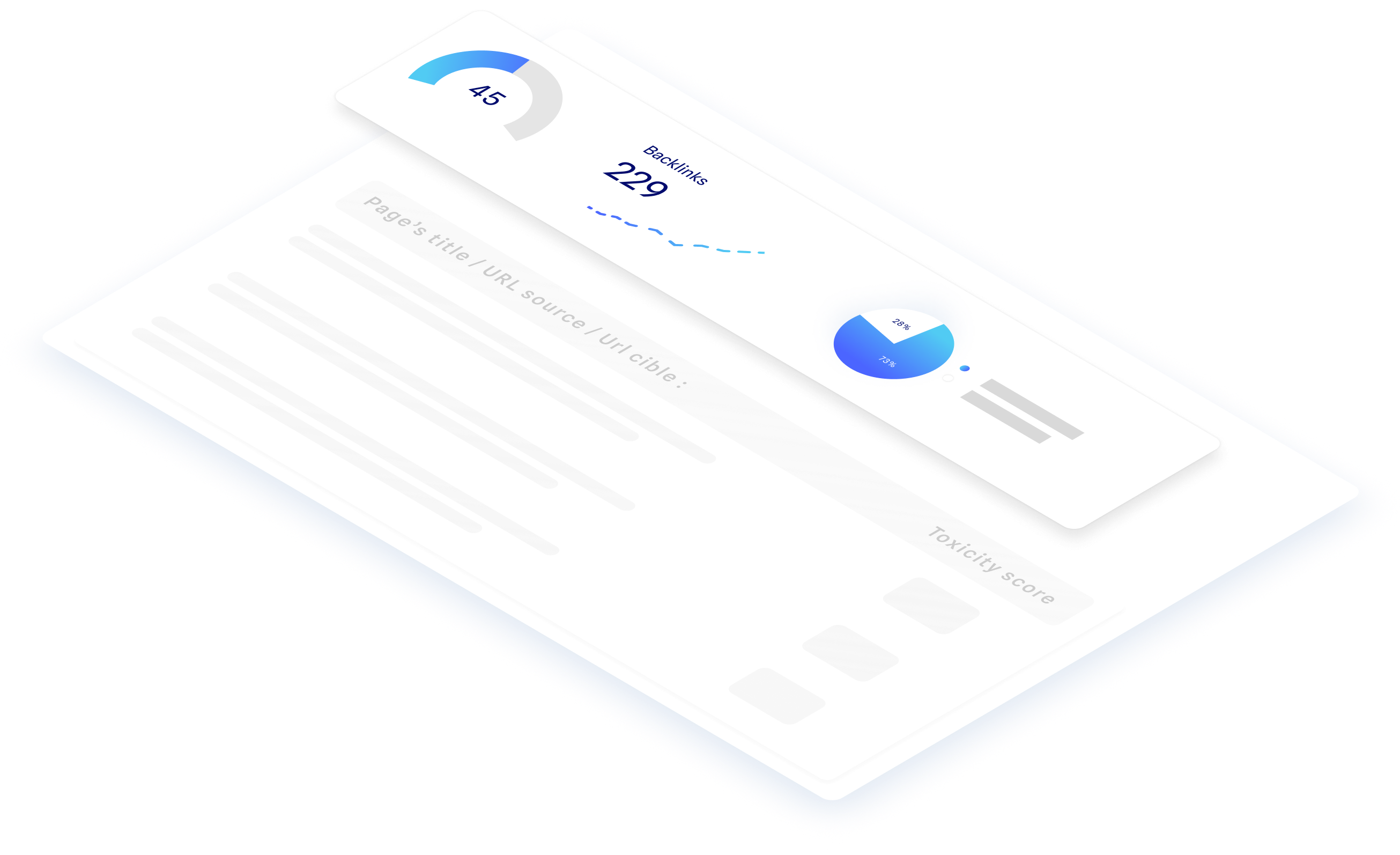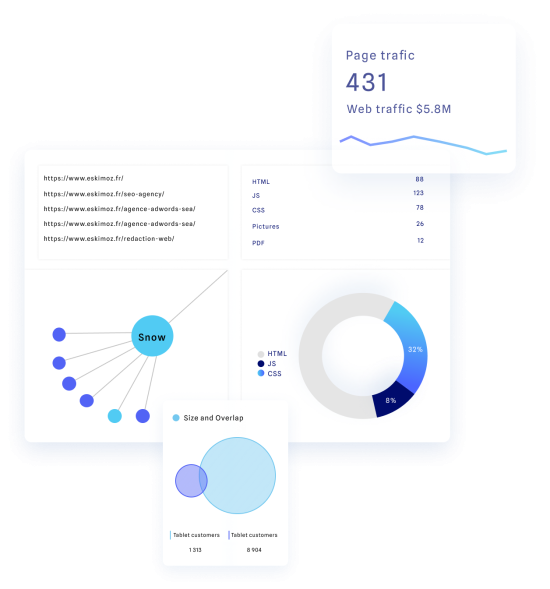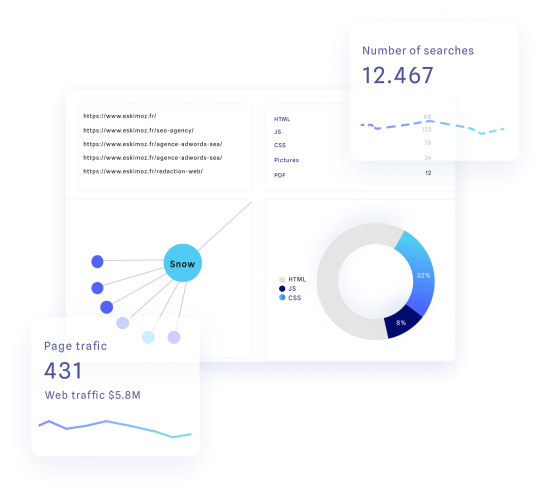Digital Uncut has been acquired, becoming the UK division of Eskimoz. Read more here

Link Building:
Building a long-term strategy
Link building is one of the most important factors in optimising your website’s organic search performance. Discover how to create an effective and enduring backlink strategy.

What is link building when it comes to SEO?
What is link building?
Link building refers to a strategy of acquiring incoming links, also known as “links,” which are published on external websites. These links redirect users to a specific page that aims to improve its search engine ranking. The essence of link building lies in utilising various methods to obtain links from reputable websites that operate within a similar theme as the page being optimised. This helps gain a portion of their authority. Due to the emphasis placed on incoming links by search engines like Google, link building has become one of the fundamental aspects of SEO and overall digital marketing. However, it’s a powerful yet delicate technique that requires careful handling.

Why is link building essential in SEO?
Search engines strive to present users with relevant search results. To achieve this, they consider various factors, including the popularity of a website. The logic is simple: the more popular a site is, the more likely it is to be considered relevant. Popularity is measured by the number of authoritative websites referring to it through published links. This concept, often referred to as “PageRank” in Google’s context, plays a significant role in determining a website’s ranking. Consequently, link building is consistently recognised by SEO experts as the primary factor in SEO, even surpassing the importance of keywords and content quality. While this consensus has been challenged in recent years, it underscores the enduring significance of link building in this field.


The benefits of link building for your website
-
Increase in popularity
Receiving incoming links from highly authoritative referring domains boosts the popularity of your site, ultimately optimising its position in the SERP.
-
Improved visibility
A popular website has a higher chance of securing prominent positions in search engine results, making it more visible to online users.
-
Increase in organic traffic
According to Search Engine Land, the top three organic links in the SERP capture 55% of clicks. Achieving a favourable ranking through link building inevitably leads to a significant increase in organic traffic.
-
Increase in referral traffic
Referral traffic refers to visitors who land on your website through external links. Links serve as entry points to your site, providing an opportunity to attract referral traffic.
-
Attainment of qualified traffic
Users who arrive at your page by following a link published on an authoritative site are more qualified and likely to take action, contributing to the growth of your website’s overall performance.
-
Growth in revenue
Link building derived traffic tends to convert more easily due to its qualified nature. This, in turn, results in a noticeable increase in your company’s revenue.
The link building glossary

-
Backlinks
A backlink, also known as an “incoming link,” refers to a link published on a third-party website that directs users back to the page you want to optimise. It’s important to differentiate it from an internal link, which connects two pages within the same domain (see “internal linking” below), and an outbound link, which guides users to an external site. The beneficiary of a backlink is the site that the link points to, not the site hosting it.
-
Linkbuilding
Link building involves the active process of acquiring links. It encompasses various strategies aimed at obtaining incoming links, in contrast to link baiting. This includes reaching out to other websites and requesting them to publish links to your desired pages or even purchasing such links. Link building is a fundamental practice in link building (see Part 3, “strategies”).
-
Link baiting
Link baiting, on the other hand, focuses on the natural generation of links in a passive manner, without actively seeking them from other sites or purchasing them. The concept of link baiting revolves around creating high-quality, valuable content that motivates internet users and webmasters to voluntarily share outbound links on their own pages.
-
Dofollow
In the realm of link building, there’s the concept of “dofollow” and its opposite, “nofollow.” These attributes provide instructions to search engine robots, guiding them on whether to follow or ignore a specific hyperlink. Dofollow links are given more value in link building, but nofollow links also have their advantages, such as generating referral traffic.
-
53%
– the share of overall traffic
that comes from organic search -
66%
of web pages
have no links pointing to them -
77%
more links
are created for long content than short content
How to differentiate between a good and a bad link
In link building, the quality of links is crucial
The link is, in a way, the key ingredient of a link building strategy, and its quality is of utmost importance. But what exactly defines a good link? There are two types: natural links, which are published either spontaneously by third-party sites or upon request, without any financial exchange, and in accordance with search engine guidelines—these are the only ones officially permitted. Then there are artificial links, which can be divided into three categories: purchased links, links published on low-quality sites or in a spamming context (such as directories, forums, comment sections under blog articles, etc.), and over-optimised links. It is advisable to focus on acquiring natural links, although it’s not always entirely within your control!

What makes for a quality link?
What criteria define a “good” link for your link building?
-
The source of the link
The quality of an inbound link depends on the hosting site: it should have strong authority, generate traffic, and be relevant to the same topic as your page.
-
The quality of the content
The quality of the written content where the link is published also plays a significant role. It should be well-written, structured using HTML tags, and sufficiently long (over 400 words).
-
The anchor text of the inbound link
Ideally, the anchor text should appear natural, semantically related to the sentence containing the link, and coherent with the topic of the targeted page.
-
The placement of the link
The position of the link on the page (preferably higher up) influences its quality, as well as the page’s position within the site’s hierarchy (whether it is closer or farther from the homepage).
-
The number of links
The originating page should have a minimum number of links to avoid diluting the “link juice.” However, be cautious: a single optimised link may raise suspicion.
-
The attribute of the inbound link
A dofollow link benefits from the authority of the originating site, while a nofollow link does not pass on link juice.
Low-quality links: what are the risks?
Link building is an incredibly powerful SEO strategy and is almost essential for achieving high rankings in the SERP. However, if not used correctly, this strategy can backfire on you! Since 2012, Google’s algorithm has included a link quality verification filter called Penguin, which can lead to severe penalties such as site demotion or even removal from the search index. This filter assesses various factors, including the authority of referral domains, link anchors, the relevance of the original site’s theme, frequency of link acquisition, and the ratio of dofollow to nofollow links. As a result, artificial links (purchased, over-optimised, or spammy) pose the highest risk in terms of search engine penalties. Recovering from a search engine penalty is a complex and time-consuming process… In summary, it is better to follow the guidelines and focus on acquiring high-quality links.

How to check your links
For the success of your link building strategy and overall SEO performance, it’s important to regularly evaluate your links. This involves analysing the quantity and quality of incoming links, assessing their reliability, monitoring the progress of your link building and link baiting efforts, and, most importantly, identifying any low-quality (“toxic”) links that need to be removed to avoid penalties. It’s important not to allow links from problematic sites, low-value pages or sections, purchased links, over-optimised links, or links deliberately created by competitors to harm your website (a common practice known as Negative SEO). Basic link checks can be performed using Google Search Console, but for more comprehensive analysis, you should utilise advanced tools such as Ahrefs, Linkody, or Majestic SEO.

What are the different netlinking strategies?
The most commonly used link building strategies

-
Purchasing inbound links
Buying links involves paying to acquire links from third-party websites, often with a strong authority. However, this practice is not endorsed by Google as it contributes to the overall devaluation of links on the web. Typically, the quality of purchased links is quite low. Therefore, it is not a recommended technique, even though it may offer quick results.
-
Engaging in link exchanges
Link exchanges, also known as “guest blogging,” involve establishing partnerships with other websites to exchange reciprocal links: from site A to site B and vice versa. This strategy can be effective if the content is of high quality, relevant, and thematically aligned, and if the links are naturally integrated. However, you should try to avoid overusing this approach.
-
Obtaining social links
Social links refer to links published on social media platforms, such as personal accounts or business pages. These links are always marked as nofollow, which limits their SEO value. However, they can still generate referral traffic. It’s recommended to have a well-rounded link profile that includes a mix of nofollow links to maintain a balanced link attribute profile and prevent arousing suspicion from search engines.
-
Creating links manually
The manual creation of links involves identifying websites, platforms, forums, or blogs that meet your criteria in terms of authority, relevance, and audience. You then publish links pointing to your pages on these platforms yourself, such as in comment sections or by contributing guest posts to affiliated blogs or news sites. While the SEO impact of this approach may be relatively low, the risk of penalties is moderate.
-
Claiming missing links
If you come across a website that has mentioned your brand or used your content but hasn’t included a link, reach out to the webmaster and politely request the addition of an inbound link. This strategy requires actively monitoring the web to identify media outlets or websites that have referenced your brand.
-
Obtaining natural links
This involves practising linkbaiting, where you create highly valuable, original, and potentially viral content that attracts both internet users and webmasters, prompting them to naturally link back to your pages. These links are completely organic, benefit from a strong semantic context, and are of exceptional quality. This is actually the technique recommended by Google.
-
Utilising press relations
Another way to employ link baiting is by leveraging press relations. By providing newsworthy information or stories to the media, you aim to secure links from high-authority sources. These natural links are placed on reputable sites, making them highly valuable. Alternatively, you can also collaborate with influencers to gain relevant links.
-
Publishing sponsored articles
Sponsored articles offer the advantage of acquiring a natural-looking link while allowing you to maintain full control over various aspects of the link creation process, including its placement on the page, anchor text, attributes, and more. Although this technique involves payment, the quality of the content and its seamless integration into the hosting site make it inconspicuous to search engines.
-
Creating a dedicated network
The technique known as “Private Blog Network” (PBN) entails establishing a network of satellite websites with different domains, enabling you to publish links at your discretion. With complete control over the content and link format, this approach can deliver excellent results. However, it requires careful management and significant effort to ensure the sites generate sufficient traffic and maintain their effectiveness.
-
65%
of marketers
see linkbuilding as the most difficult SEO tactic to implement. -
60%
of companies
entrust their link building strategy to an agency. -
97%
– the percentage of additional links
generated by companies that engage in blogging.
Best practices for link building
Developing an effective and sustainable link strategy
A well-crafted link building strategy can be a game-changer, but it’s important to tread carefully. While high-quality links can bring numerous benefits, low-quality or toxic links have the potential to harm your site’s rankings and undo your SEO efforts. That’s why your link building strategy should prioritise effectiveness and longevity. It’s crucial to determine the best approach based on your specific needs and goals and then optimise your inbound link strategy accordingly. To assist you in this endeavour, we’ve outlined some tried-and-true best practices for link building.


Best link building practices (to optimise your strategy)

-
Create compelling and valuable content
To attract organic links naturally, focus on creating content that stands out. Craft high-quality, informative, and relevant content that captivates your target audience and compels them to link back to your pages. A strategic content marketing approach is key to driving these organic links.
-
Direct links to relevant pages
When possible (such as when purchasing links, engaging in manual outreach, or leveraging sponsored articles), carefully consider the destination pages for your links. These pages should align with the content of the host site and offer value from a marketing or commercial standpoint. For example, prioritise linking to specific internal pages like services, products, or relevant blog categories, rather than solely relying on the homepage.
-
Analyse site metrics
Select target sites for your link building efforts based on two critical metrics: Trust Flow, which measures the level of trustworthiness, and traffic volume. These insights, provided by tools like Majestic SEO and SEMrush, help you identify the most impactful sites that can enhance your authority. However, exercise caution and don’t blindly rely on these metrics alone.
-
Examine competitor links
Don’t hesitate to study your competitors’ link profiles. Analyse the domains that are linking to their pages and take note of their anchor text strategies. Armed with this information, you can approach the same sites and strive to secure your own links, benefitting from their established authority and relevance.
-
Vary the referral domains
Bring variety to your link building by targeting different referral domains. At the same time, aim to publish several links on one high-quality third-party site, as long as it is qualitative and shares similar themes to yours. From a search engine perspective, it is logical to be cited multiple times as an expert.
-
Create complex link exchange patterns
If you engage in link exchanges, opt for complex schemes, preferably triangular ones. This involves three sites (a link from A to B, another from B to C, and a final one from C to A) rather than just two. This allows for better utilisation of “link juice” and reduces search engine suspicions.
-
Avoid mass acquisition of links
If you are considering purchasing links to boost your link building, it’s advisable to steer clear of low-quality directories and link farms. These link building techniques are no longer favoured by search engines and are subject to severe penalties. Instead, focus on acquiring “natural” links (such as through sponsored articles) or concentrate on high-quality directories without excessive use.
-
Pay attention to anchor profiles
Search engines place significant importance on the anchor text of links pointing to your site. These anchors can be optimised with strategic keywords or be natural, incorporating brand names, raw URLs, or phrases like “click here.” A good ratio to aim for is 20% optimised anchors and 80% natural anchors.
Video: 6 tips to optimise your link building
Our Commitment
-
Expertise
Since 2010, we have worked with over 2000 clients across 90 countries.
-
Passion
We are a team of passionate, industry-focused individuals who are committed to your success.
-
Performance
We’re committed to implementing a data-driven strategy, making a real impact on your bottom line by providing avenues for growth.
Any questions?
Link building is a technique used in search engine optimisation that involves creating or acquiring incoming links (links) for a website. These links, found on external websites, point to the pages that need optimisation. Link building can be an active process known as “linkbuilding,” which involves building a network of links. It can also be a passive approach called “linkbaiting,” where links are naturally generated by users themselves.
Link building is a fundamental aspect of SEO. Search engines place significant importance on the concept of popularity when ranking pages. A website that receives numerous links from reputable and authoritative domains is considered popular, and relevant, and will achieve a better position in the SERP. Link building is also a way to attract qualified referral traffic to your website.
There are various strategies for link building. To obtain high-quality links, it is advisable to choose validated approaches or those that are at least tolerated according to search engine guidelines. For example, creating natural links through link baiting, exchanging links through guest blogging, obtaining social links, utilising press relations, and more. It’s also important to optimise your link building strategy to maximise its effectiveness.







